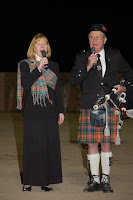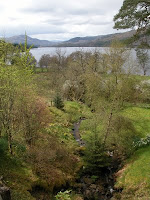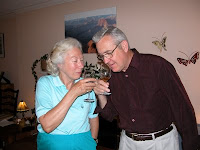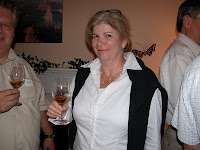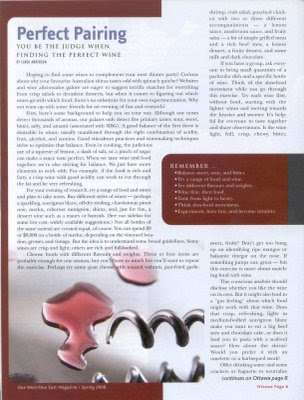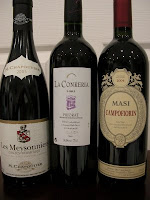 Generally speaking, there are three groups of wine purchasers. Without any kind of scientific study on the matter, I'm fairly certain that most folks fall into the first group, with a growing number in the second group. I don't know anyone who wouldn't rather be in the third group!
Generally speaking, there are three groups of wine purchasers. Without any kind of scientific study on the matter, I'm fairly certain that most folks fall into the first group, with a growing number in the second group. I don't know anyone who wouldn't rather be in the third group!The first group keep a few bottles on hand at home, usually in a wine rack in the kitchen or dining room. They drink a few and when they're down to a couple, they go out and buy some more and the process continues. If they're visiting friends for dinner, they tend to pop into the local liquor store to buy a bottle, and don't usually take one from the wine rack at home. They have a few kinds of wine they really like, and buy them regularly - could be a varietal like Chardonnay or a particular Cabernet Sauvignon from a particular grower, or any Shiraz (let's say) from Australia, because they like Australian Shiraz. Comfort price ranges for this group varies somewhat, depending on individual financial circumstances, but typically will be in the $7 to $20 range. Occasionally they visit a friend or a restaurant and taste something they like and add it to their repertoire. They are comfortable asking LCBO consultants for advice and will sometimes pick up the LCBO staff pick of the week. No bottle of wine lives in the wine rack for more than a couple of months.
 The middle group is passionate about wine and all things oenological, and its members would love to be part of group three. They have 50 to 200 wines in some kind of cellar - either a cooler storage area or a couple of large wine fridges or perhaps a modest cellar room, and they search out great value wines both for drinking within six months and for laying down for a few years. They try to stay current with good vintages in different regions, and seek out wines with good aging potential. They have a decent range of wines in store, from light crisp whites to luscious Viogniers, new world Pinot Noirs to big Syrahs, a few sweet wines and some sort of bubbly. They can usually find something in the collection to pair with whatever's on the dinner table and will generally select something from their stock to give to a dinner host. The average cost of a bottle of wine is about $20.
The middle group is passionate about wine and all things oenological, and its members would love to be part of group three. They have 50 to 200 wines in some kind of cellar - either a cooler storage area or a couple of large wine fridges or perhaps a modest cellar room, and they search out great value wines both for drinking within six months and for laying down for a few years. They try to stay current with good vintages in different regions, and seek out wines with good aging potential. They have a decent range of wines in store, from light crisp whites to luscious Viogniers, new world Pinot Noirs to big Syrahs, a few sweet wines and some sort of bubbly. They can usually find something in the collection to pair with whatever's on the dinner table and will generally select something from their stock to give to a dinner host. The average cost of a bottle of wine is about $20. The third group comprises serious wine drinkers with pots of money. They know wines, have tasted a lot, collect wines for laying down as well as for more immediate drinking, have enviable cellars and a wide range of varietals and blends from all the major wine growing regions of the world, as well as rare and obscure bottles. They love to share their wines with like-minded wine lovers and interested neophytes. They are generous and knowledgeable and, contrary to popular belief, few of them are wine snobs.
The third group comprises serious wine drinkers with pots of money. They know wines, have tasted a lot, collect wines for laying down as well as for more immediate drinking, have enviable cellars and a wide range of varietals and blends from all the major wine growing regions of the world, as well as rare and obscure bottles. They love to share their wines with like-minded wine lovers and interested neophytes. They are generous and knowledgeable and, contrary to popular belief, few of them are wine snobs.I'm pretty much in the middle group with aspirations to join the third group when we win the lottery. Fortuitously, I live in a house with a cold storage room. Whether as a result of a botched insulation job or an actual plan by a previous owner or the builder, we don't know, but it serves very well as a place to store wines - as well as our tools, too much sports equipment, a cupboard full of miles of cables too complicated to sift through, and various other random things which have no place in a real wine cellar. Wines intended for any kind of longer term storage prefer being left alone in a cool, dark place, with the right humidity level and no vibrations or odours.
 I like to seek out wines of great value rather than big price. There is a bit of a correlation though and, often, more expensive wines are better wines with more elegance and structure. That said, there are thousands of wines in an affordable price bracket and it's enormous fun to find them. If I visit wine regions, I like to taste what's local and good and bring some back. This has much greater scope if one is visiting Niagara as opposed to somewhere in Europe, since it's easier to load up the trunk rather than a suitcase, and the taxes and duties are a little more predictable.
I like to seek out wines of great value rather than big price. There is a bit of a correlation though and, often, more expensive wines are better wines with more elegance and structure. That said, there are thousands of wines in an affordable price bracket and it's enormous fun to find them. If I visit wine regions, I like to taste what's local and good and bring some back. This has much greater scope if one is visiting Niagara as opposed to somewhere in Europe, since it's easier to load up the trunk rather than a suitcase, and the taxes and duties are a little more predictable. I also pay attention to the bi-weekly Vintages releases at the LCBO, do some homework and pick up things that sound interesting, either for drinking soon or for keeping for a few years. I love Bordeaux wines and buy futures through Vintages. Not the high end stuff (group two, remember!) but wines that some of my favourite knowledge sources, like Jancis Robinson, believe to be good value. The big advantage to buying Bordeaux wines in a good year, while they're still in the barrel is that you buy them at a fraction of the price you'll pay 5 to 10 years down the road when they're at their drinking prime. Lots of friends wonder at this ability to buy wines and not drink them, but the trick is easy enough. Just keep enough around for current drinking and there's no need to touch the stuff you're laying down. Just label the shelves or a spreadsheet with a not before date and leave it alone. Really just the opposite of using up the yogurt in the fridge by the not after date! This is a much cheaper process in the long run and you'll drink yummier wines.
I also pay attention to the bi-weekly Vintages releases at the LCBO, do some homework and pick up things that sound interesting, either for drinking soon or for keeping for a few years. I love Bordeaux wines and buy futures through Vintages. Not the high end stuff (group two, remember!) but wines that some of my favourite knowledge sources, like Jancis Robinson, believe to be good value. The big advantage to buying Bordeaux wines in a good year, while they're still in the barrel is that you buy them at a fraction of the price you'll pay 5 to 10 years down the road when they're at their drinking prime. Lots of friends wonder at this ability to buy wines and not drink them, but the trick is easy enough. Just keep enough around for current drinking and there's no need to touch the stuff you're laying down. Just label the shelves or a spreadsheet with a not before date and leave it alone. Really just the opposite of using up the yogurt in the fridge by the not after date! This is a much cheaper process in the long run and you'll drink yummier wines.If I find a wine of outstanding value at a tasting, I'll sometimes buy a case from the agent, if it's not available from the LCBO. If you try something in a restaurant that you love, you'll see the agent's name on the bottle and can buy it direct by the case.
 I like to keep a range of wines in the "cellar" so that there's always something to work with whatever food ends up on the table. Great food and wine pairing is one of life's joys and it's annoying to serve up a rich winter lamb casserole if the only thing down there is Sauvignon Blanc (an extreme example). So, what does a range of wines mean? For me, it's a broad selection of varietals from different regions and countries, different types (sparkling, white, rose, red, sweet, fortified) and, different weights of wines from light to rich to complement a variety of foods.
I like to keep a range of wines in the "cellar" so that there's always something to work with whatever food ends up on the table. Great food and wine pairing is one of life's joys and it's annoying to serve up a rich winter lamb casserole if the only thing down there is Sauvignon Blanc (an extreme example). So, what does a range of wines mean? For me, it's a broad selection of varietals from different regions and countries, different types (sparkling, white, rose, red, sweet, fortified) and, different weights of wines from light to rich to complement a variety of foods.So here, a partial list of what's lurking in the multi purpose "cellar"
- A variety of sparkling wines from France and Spain. Spanish Cava is a great buy and the several Cremant sparkling wines of France also offer terrific value. Sadly, no Champagne at the moment.
- Some Chasselas from Switzerland - hard to find in the LCBO, but perfect for Cheese Fondue
- Sancerre from the Loire and Sauvignon Blanc from New Zealand and Niagara. Same varietal but completely different styles.
- Pinot Gris from Niagara and Alsace. I LOVE Alsace Pinot Gris, Riesling and Gewurztraminer.
- Riesling from Alsace and Niagara, in various degrees of dry and off-dry. There's some great Grand Cru Riesling from a trip over there last year and some spectacular small lot Riesling from Niagara's Thirty Bench - my favourite in Ontario. Riesling is a very versatile food wine.
- Chenin Blanc from the Loire, also in various levels of dry to quite off-dry and also some from Mexico, which is tasty and very good value.
- A range of Chardonnays, more on the steely, unoaked or low oaked side - Chablis, Argentinian Chard from higher altitudes, Italian Chard from Alto Adige, Chilean, some Californian, few Australian.
- Some Viognier, Gewurztraminer, Southern Rhone blends of Viognier, Marsanne, Grenache Blanc, Bourboulenc, Clairette and a few others.
- Various dessert wines from France, Austria, Germany, Ontario, California (fabulous Black Muscat). Walnut Brown and other sweet sherries. Late Bottled Vintage and Tawny Ports.
- Lots of Niagara reds at the moment, including Pinot Noir, Cab Sauv, Merlot, Cab Franc, Meritage Blends - even some Vineland Reserve Syrah 2006, which I'm keeping.
- Quite a few Spanish reds from all over. Generally speaking - fantastic value wines.
- The aforementioned Bordeaux wines - some for keeping, some for drinking now. We tried a 2005 Tour St Bonnet Medoc wine the other evening with a medium rare piece of filet and it was superb. The wine is young but the uncoagulated proteins in the rare meat work in harmony with the tannins in the wine. It'll be even more tasty and versatile a few years down the road, when it will sell for probably $28 to $32, if available. I paid $17 through the Futures route.
- Generally lots of French red from all the different regions of France. A year living there allowed lots of opportunity to sample the many delights.
- Not enough Italian or Californian wine at the moment. Must rectify that.
- A good collection of BC reds from some recent trips out west. Generally excellent.
- Very few Australian reds. I'm not a big fan of jammy taste and find I have to get into pricier wines to find what I like. Having said that, I visited the country a couple of years back and almost everything was terrific.










 Since Hillebrand was almost next door to our B and B, we ended the day there. One of the biggest and longest established wineries in the region, the place was also hopping, but with lots of staff to handle the crowds. Hillebrand created Niagara’s first Icewine in 1983 and opened the first winery restaurant in Niagara-on-the-Lake in 1996. We headed up stairs to the Collector’s Boutique and tasted some very fine wines indeed. The Showcase Merlot 2004 is drinking very nicely now. The 2002 should have been better, given the vintage, but the bottle we tasted had a nasty nose, little fruit and was lighter than expected. Perhaps we just had a bad bottle. The whole scene upstairs was excessively busy and noisy – it was a Saturday after all - with people screaming with delight at each other across the tasting area, so I didn’t ask if another bottle could be opened. The Showcase Merlot 2000 was wonderful, complex and exciting, with lots of flavour, great balance and a long, delicious finish. Pricey, but very good. In the Cabernet Sauvignon verticals, the 2002 was outstanding. We were given further verification here that 2007 was going to be an outstanding vintage – the best since 2002. I look forward! Of the Hillebrand ice wines we tasted, the 2007 oak aged Vidal was beautifully balanced.
Since Hillebrand was almost next door to our B and B, we ended the day there. One of the biggest and longest established wineries in the region, the place was also hopping, but with lots of staff to handle the crowds. Hillebrand created Niagara’s first Icewine in 1983 and opened the first winery restaurant in Niagara-on-the-Lake in 1996. We headed up stairs to the Collector’s Boutique and tasted some very fine wines indeed. The Showcase Merlot 2004 is drinking very nicely now. The 2002 should have been better, given the vintage, but the bottle we tasted had a nasty nose, little fruit and was lighter than expected. Perhaps we just had a bad bottle. The whole scene upstairs was excessively busy and noisy – it was a Saturday after all - with people screaming with delight at each other across the tasting area, so I didn’t ask if another bottle could be opened. The Showcase Merlot 2000 was wonderful, complex and exciting, with lots of flavour, great balance and a long, delicious finish. Pricey, but very good. In the Cabernet Sauvignon verticals, the 2002 was outstanding. We were given further verification here that 2007 was going to be an outstanding vintage – the best since 2002. I look forward! Of the Hillebrand ice wines we tasted, the 2007 oak aged Vidal was beautifully balanced. 



